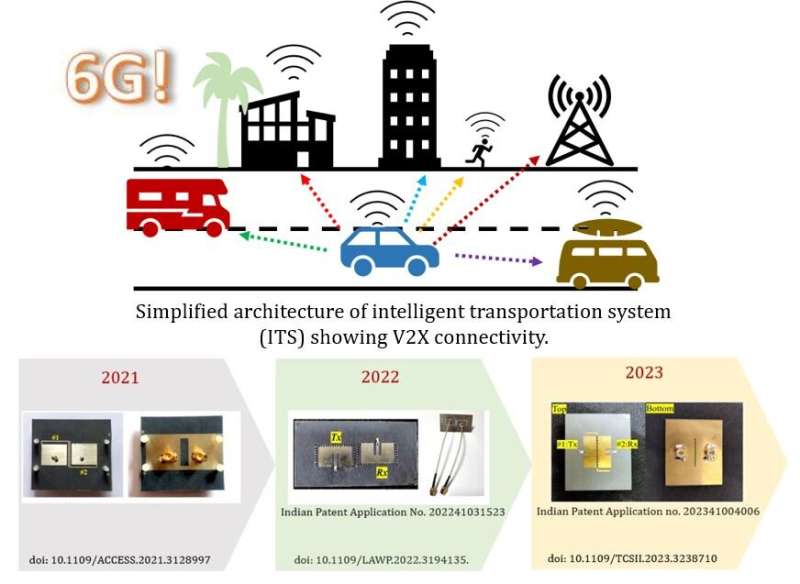This article has been reviewed according to Science X's editorial process and policies. Editors have highlighted the following attributes while ensuring the content's credibility:
fact-checked
trusted source
proofread
Designing antennas for 6G V2X (Vehicle to Everything) communication

Researchers at the Indian Institute of Science (IISc) are working on designing antennas that can empower 6G technology, which is instrumental in realizing efficient V2X (Vehicle to Everything) communications.
In a recent study, the team, led by Debdeep Sarkar, Assistant Professor at the Department of Electrical Communication Engineering, shows how self-interference in full-duplex communication antennas can be reduced, and consequently the movement of signals across the communication network can be faster and more bandwidth-efficient. Such full-duplex antennas are particularly helpful for applications that require almost instantaneous relay of commands, like driverless cars.
Full-duplex antennas consist of a transmitter and a receiver to send and receive radio signals. Traditional radio transceivers are half duplex, which means that they either use signals of different frequencies for sending and receiving or there is a time lag between the signal transmitted and the signal received.
This time lag is needed to ensure that there is no interference—the signals going back and forth should not cross paths with each other, similar to two people talking to each other at the same time, without pausing to listen to the other. But this also compromises the efficiency and speed of signal transfer.
In order to transmit data much faster and more efficiently, full-duplex systems are required, where both the transmitter and receiver can operate signals of the same frequency simultaneously. For such systems, eliminating self-interference is key. This is what Sarkar and his IoE-IISc postdoctoral fellow, Jogesh Chandra Dash, have been working on for the past few years.
"The broad objective of the research is that we want to eliminate the signal that is coming as self-interference," says Sarkar. There are two ways to cancel self-interference—passive and active. Passive cancelation is done without any additional instrument, by just designing the circuit in a certain way (for example, increasing the distance between the two antennas).
Active cancelation relies on additional components like signal processing units to cancel out the self-interference. But the components needed for these steps can make the antenna bulky and expensive. What is needed, instead, is a compact, cost-efficient antenna which can be easily integrated into the rest of the circuitry of any device.
The antenna developed by Sarkar and Dash, by virtue of its design, relies on passive interference, allowing it to operate as a full-duplex system. It consists of two ports, either of which can act as transmitter or receiver.
The two ports are isolated from each other by electromagnetic tools called metallic vias. Metallic vias are holes drilled into the metal surface of the antenna which disrupt the electric field. In this way, the team managed to cancel out most of the interference passively, alongside achieving a cost-effective and compact design.
"We are eliminating all the conventional techniques for self-interference cancelation, and we are integrating a very simple structure that can be installed in a car," says Dash.
In the immediate future, the team plans to optimize their device so that it can entirely remove passive interference, and reduce the overall size of the antenna. Then, it can easily be fixed onto a vehicle where it can transmit and receive data at very high speeds, bringing driverless operation as well as 6G mobile connectivity closer to reality.
The findings are published in the journal IEEE Transactions on Circuits and Systems II: Express Briefs.
More information: Jogesh Chandra Dash et al, A Co-Linearly Polarized Shared Radiator Based Full-duplex Antenna with High Tx-Rx Isolation using Vias and Stub Resonator, IEEE Transactions on Circuits and Systems II: Express Briefs (2023). DOI: 10.1109/TCSII.2023.3238710



















